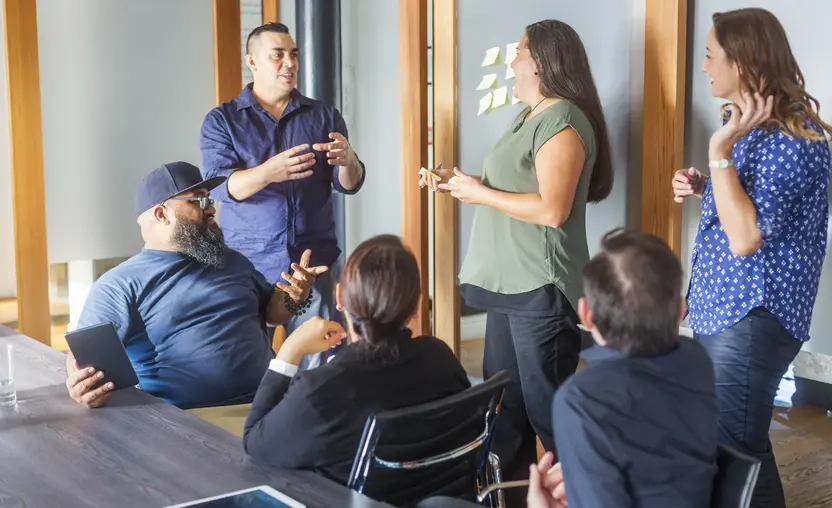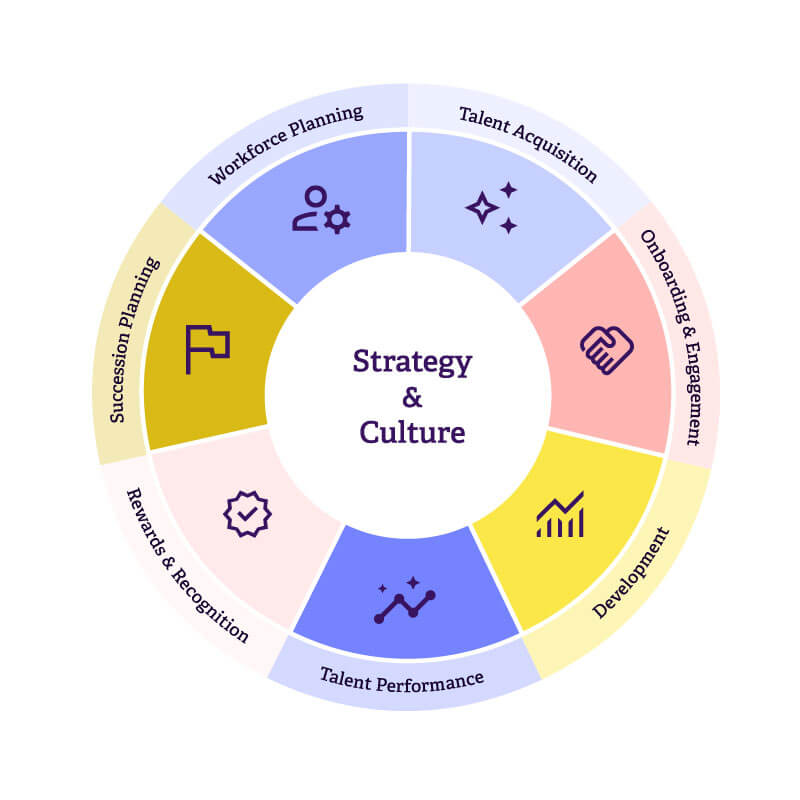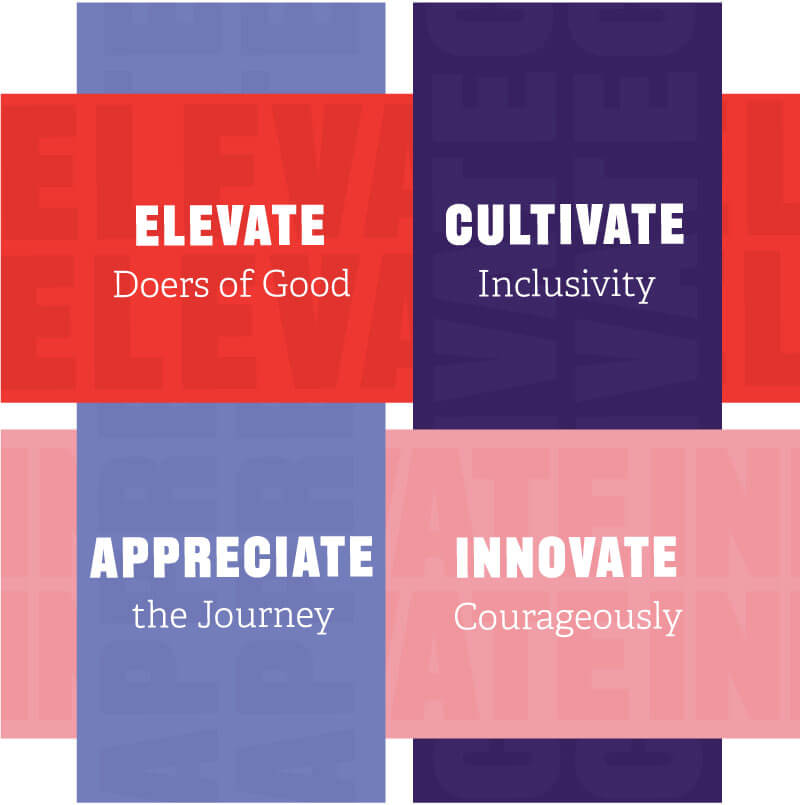Achieve meaningful social impact with intention, integration, and collaboration

It’s no secret that employees want to work for purpose-driven companies—83% of Gen Z in the U.S. consider a company’s purpose when deciding where to work, and 84% of millennials want their company to help them get more involved in their communities. In the era of the “Great Resignation,” engaging employees in your company’s purpose is key to employee engagement, retention, and recruitment efforts.
During From Day One’s August conference, Offering Workers Dignity, Purpose, and Fulfillment, Bonterra’s Pete Karns, General Manager, Corporate Social Responsibility (CSR), interviewed Terilyn Juarez Monroe, Chief People Officer, Bonterra, about accelerating social impact efforts while attracting & retaining employees by connecting CSR to your company’s diversity, equity, inclusion, and belonging (DEIB) efforts, leadership development, and much more.
If you missed the session, you can watch the full conversation!
Don’t have time for the full session right now? Check out the highlights and key takeaways below.
The business of people
Pete: Bonterra was formed by bringing together four different companies that serve various dimensions of the social good space. Nearly a year after our initial formation, we’re currently in the process of growing the team materially and actively working to develop our corporate culture. In many ways, we represent the ultimate case for the importance of corporate social responsibility as it relates to our engagement, connection to purpose, and diversity, equity, inclusion, and belonging efforts. Terilyn, can you share how you view the role of HR in bringing these companies together?
Terilyn: Having a role within the HR function means we are in the business of people. Just like any business, we have sales representatives, a product we’re selling, and customers we’re trying to target. I like to think of our recruiters as salespeople who are tasked with selling the company and its open roles, offerings, and services to customers. Our customers are potential candidates, employees, and alumni. All of these different dimensions of the people business come together to form a talent ecosystem that is comprised of seven pillars.

Although these pillars represent different dimensions of your business and the employee experience, it’s important to approach all components of the ecosystem from a strategic perspective with your culture in mind. Within corporate culture is where DEIB and CSR exist—they’re not mutually exclusive and they’re not separate programs. Instead, they should be infused into every element of your business and inform who you are and what you do as an organization.
The end-to-end employee experience
Pete: Terilyn, I know you have a unique framework that describes the lifecycle of an employee with a company. Can you share that with us and discuss how CSR can be infused throughout the entire experience?
Terilyn: When thinking about candidates, employees, and alumni, there are pivotal moments that matter across an individual’s journey with a company. We know that businesses are always thinking about moments that matter for customers, and sometimes they’re referred to as moments of truth. This might be when a customer thinks, “I want to buy this product” or “I had a bad experience, I’m going to try a new product.” This also translates into moments that matter for employees across the end-to-end employee experience.

These elements are critical when thinking about DEIB and CSR—they cannot exist at a single point in time and must be infused throughout the entire experience. So, when a candidate hears about your company–what makes you special and your values–they’re not just hearing it but they can actually see it in action. They’re seeing quotes on your website, they’re hearing about it in conversations with hiring managers, and once they’re onboarded as an employee, they’re living it, too! Even after an employee leaves your company, there may still be ways to engage them in your CSR efforts.
Pete: How do you think elements of CSR like volunteerism can relate to leadership development?
Terilyn: When you think about CSR programs like skills-based volunteerism, it becomes apparent that while this is a great way to give back it’s also a wonderful opportunity to develop your internal leaders. For example, if you can identify an organization that reflects your DEIB values and offer skills-based volunteerism opportunities, your employees can give back and refine their skills. And as a result, you have just connected three very important components.
If you think about CSR, DEIB, and leadership development as separate programs, they can begin to feel like add-ons or extra work. But when you take an interconnected approach, your workforce is more likely to get involved. As a result, you’ll drive greater impact for causes and employees alike.
Pete: Let’s discuss affinity groups or employee resource groups (ERGs) as a means to create connectivity or belonging within an organization. What’s your position on these types of groups?
Terilyn: ERGs can support community-building and belonging efforts within your business. This is especially true when various ERGs begin to work together. At a previous organization, we had two ERGs—Christian Network and Pride Network—that would often come together for volunteer events or host panel discussions. This connects back to the importance of interconnectivity between your CSR and DEIB programs. When both of these efforts are deeply intertwined, this is when community building happens and your employees experience a greater sense of belonging to your organization.
ERGs are also an excellent resource for elevating your employees’ voices, gauging their opinions, and channeling their expertise. If you’re planning to launch a new product, for example, you can reach out to these groups and ask their opinion on the upcoming launch or feature. And this is a powerful opportunity to celebrate the diverse experiences that exist within your organization.
However, your organization needs to be prepared for ERGs. It’s imperative to identify what you’re solving for and build a supportive infrastructure for employees who volunteer their time. And remember, ERGs cannot be your sole DEIB strategy! Instead, they should complement your existing programs or initiatives.
Your employees want to have their voices heard! And it’s no longer enough to circulate monthly or quarterly engagement surveys. Your workforce is finding their own channels of communication that allow for the exchange of thoughts, ideas, opinions, etc. It’s important to hear what your employees are saying and harness their thoughts into company improvements. And when decisions are informed by the diverse perspectives of your workforce, the more your business will thrive.
Foster a value-driven culture
Pete: Bonterra is less than a year old, and we’re in the process of combining multiple companies into one that has a very large responsibility. As a result, we have been very intentional about our values and our culture. Let’s dig into that and discuss why it’s important to connect your values to workplace belonging and inclusion. How do you take these concepts from ideas to reality?
Terilyn: At Bonterra, we were presented with a truly unique opportunity to create something that has never been done before. Not just strategically, but culturally, too!
We engaged Great Mondays and Josh Levine to help build a strategic framework around culture. During one of our initial meetings, we were eager to jump straight to defining our values. Josh and his team helped us to take a step back and examine our company culture with a holistic view. You cannot define your values without first understanding your purpose and behaviors as well.
As a result, we spent a lot of time thinking about who we are as a company and our brand persona—the optimistic advocate. An important part of this process was engaging our employees. As we discussed before, your workforce is a powerful pool of diverse opinions, perspectives, and experiences. Therefore, we gathered 18 employees who worked together to develop our values.
See the results below!

A critical component of this process was that our ambassadors were not executives. They represented employees across all the different entities that came together to create one Bonterra. CSR and DEIB are infused across our four new values. For example, elevating doers of good relates directly to CSR. It’s who we are as a company but it’s also a call to action and articulates that it’s not just about our products driving social impact, it’s also about helping others do good. Values become extremely powerful when translated into action, linked to your purpose, and infused throughout the employee experience. As the team created our values they kept asking, “What can we do to power those who power social impact?” which is a direct connection to our purpose statement.
Reframing the Great Resignation as the “Great Re-Recruitment”
Pete: We’re currently living through what many are calling the Great Resignation, which describes the state of the labor market and how companies are struggling to attract and retain top talent. However, there is an alternative perspective on what’s happening with the workforce, and I’d love for you to share your thoughts on the subject.
Terilyn: The Great Resignation has actually been here for quite a while now, but it’s all about perspective. What if we thought of it as the “Great Re-Recruitment?” And what if we directed our focus away from the problem and towards the solution—employee engagement? Focus on how you can better engage your workforce.
Start with your company’s purpose and what makes you special. Now think about your CSR efforts and how you can connect those to DEIB and your identity as a business to re-engage your employees. Now more than ever before, it’s imperative that you listen to your employees’ opinions and adapt or pivot programs based on their feedback. Employees want to be heard and expect companies to take action. Whether it’s in response to a social movement or an emerging crisis, businesses are expected to take a stand and show support. In doing so, you will re-engage your workforce and attract new talent.
Key takeaways
- The business of people: CSR and DEIB programs should be infused across your talent ecosystem (hiring, leadership development, etc.).
- The end-to-end employee experience: Don’t think about CSR and DEIB as separate initiatives. Instead, get creative and consider ways they can be connected across the end-to-end employee experience (from the moment someone hears about your company to after they have left and become alumni). Skills-based volunteerism is a great starting point!
- Employee Resource Groups (ERGs): Affinity groups or ERGs are a great way to garner employee feedback about what’s working and what’s not. But before implementing these kinds of programs, it’s imperative to have strategy and infrastructure in place!
- Value-driven culture: Company values play a key role in informing corporate culture, but values alone cannot define your culture. Corporate culture starts with your purpose and is reinforced through your norms, social cues, rewards, rituals, and behaviors.
- The Great Re-Engagement: The current state of the labor market has left many companies grappling with how to attract and retain top talent. Direct your focus away from the problem and focus on the solution—driving employee engagement.
See how Bonterra can help
Connecting CSR and DEIB efforts to your talent ecosystem can be a powerful tool for recruitment and engagement efforts. However, standing up a meaningful and sustainable program is often easier said than done. See how Bonterra’s CSR Software can help streamline and simplify your efforts.
Ready to Get Started?
Work with Bonterra



